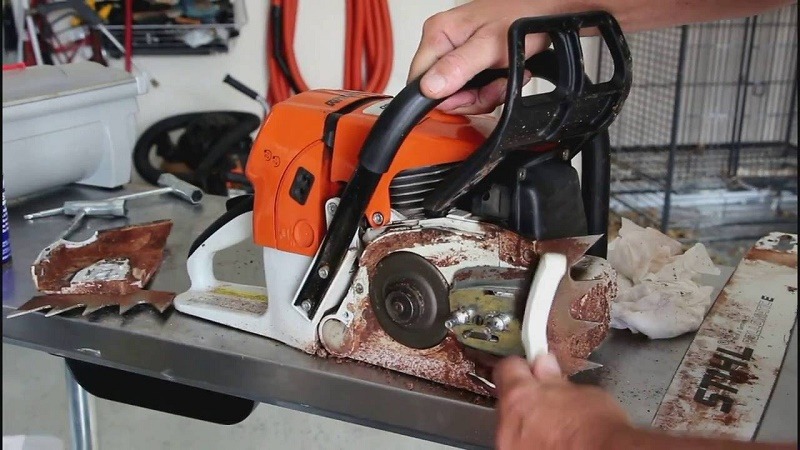Table of Contents
[As an Amazon Associate I earn from qualifying purchases. Learn more]
Chainsaws, just like every other piece of equipment, are prone to dirt, dust, and debris. The accumulation of these problems on chainsaws definitely has a bearing on their performance. They may also pose some safety risks to you such as the spread of tetanus. It is only by cleaning this equipment thoroughly from time to time that the associated problems may be curbed.
Our goal in the conversations that follow shall be to take you through the typical chainsaw cleaning process. We shall also examine a couple of frequently asked questions regarding the subject matter of chainsaws.
Tools and Materials Required
- Powerful detergent
- Water soap
- Scrubbing brush
- Clean cloth
- Steel wool
Step-by-step Procedures
Step I: Uncover the chainsaw
Start off by uncovering your chainsaw. Do so by removing the clutch cover of the chainsaw. This is to grant you access to the torque converter, flywheel, and the entire transmission system. After you have uncovered it, leave it exposed for the sake of cooling the engine and the entire interior of the chainsaw.
Step II: Clean the chain brake band
Commence the cleaning exercise with the chain brake hand. Clean it properly by using soap, water, and scrubbing brush. Be slow and meticulous as you engage the grooves. You want to rid these parts of the hardened and stubborn stains. You might also use steel wool to access those ordinarily hard-to-reach areas.
Step III: Wipe the bar clean
Move on to the bar. Clean it using soap and cloth. You may also have to scoop out any debris which might have been trapped in between the constituent parts and components. Yet again, go slow on this issue. You might leave out some dirt if you rush through the process.
Step IV: Uncover the cylinder
Now uncover the cylinder. The cylinder is the core of the chainsaw. It is the component which contains the pistons which generate the torque. Do not interfere with the structure of the cylinder at all. You might pose some permanent damages to the chainsaw if you attempt to do so. Yet again, leave it to cool.
Step V: Wash the air filter
Proceed to wash the air filter. The air filter is the one that rids the air entering the internal combustion chamber of any dust or debris. It is hence generally susceptible to clogs and other forms of blockages. Cleaning the air filter thus to a large part entails unclogging it. Use a dust blower to remove them.
Step VI: Work on the air intake and cooling fins
After this, move on to the air intake and the cooling fins. Check out for any debris which might be stuck in these parts. Clear them out using the dust blower or some sharps sticks like the toothpick. Wash them thoroughly using mild detergent and plenty of water.
Step VII: Examine the flywheel pins
Lastly, examine the flywheel pins. See to it that there exists no blockage of the air path which might compromise the cooling of the engine. In case any blockage exists, use a dust blower to get rid of them. Wash them yet again using clean water and mild detergent.
PS: Please note that each manufacturer has its own preferred means of cleaning the chainsaw. It is hence vital for you to refer to your manufacturer’s manual for the best way forward. That is necessary also to prevent any unnecessary issues which might interfere with the proper functioning of the equipment altogether.
FREQUENTLY ASKED QUESTIONS (How To Clean Your Chainsaw)
Q1. When was the chainsaw invented?
A. The modern chainsaw as we know it was invented in 1830 by one Bernhard Heine, who was a German orthopaedist.
Q2. What are the best brands of chainsaws?
A. Some of the best brands of chainsaws in existence today are the Stihl, Husqvarna, Jonsered, and Echo.
Q3. Between the gas and electric chainsaw, which is the better option?
A. Electric chainsaws are undoubtedly the better options between the gas and electricity varieties. The reasons underlying this are that they are quieter, exude more power, are cleaner, and perform numerous operational cycles. On the flipside, they are quite expensive and are hence beyond the reach of many deserving would-be owners.
Q4. How many amperes does a typical chainsaw consume?
A. A typical chainsaw consumes around 10 amperes give or take. The consumption is however determined by the intended role as well as the sheer size and construction of the chainsaw.
Q5. Which is the best lubricating oil for a chainsaw?
A. Most manufacturers recommend the use of petroleum-based oils for lubricating their tools.
CONCLUSION
Cleaning a chainsaw is not so difficult a task more so if you have the right gears. However, it is a meticulous undertaking which is not for persons who lack the patience needed. The ball is now on your court. It is up to you to see to it that you exercise the necessary patience. All the best in your next cleaning process!

